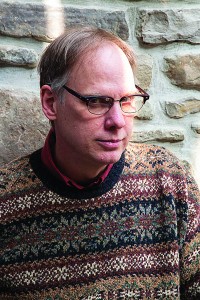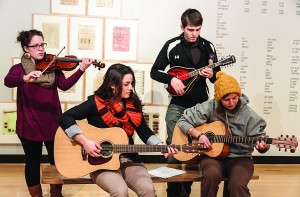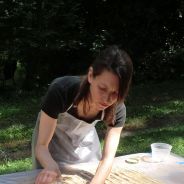This year’s faculty art exhibition features work from professors Gary Baxter, David Huth, Ted Murphy, and John Rhett. The collection is open from January 25 to February 29, and the gallery opening is this Friday, February 5.
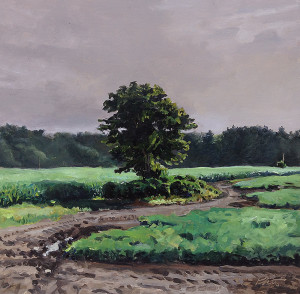 This year, Baxter’s contributions include a selection of slab-made bowls and a tower-like installation of mugs. He has continued his explorations of texture with the variety of materials he used to make impressions in the surfaces of the vessels, draping the slabs over different forms to shape them. His work is largely inspired by fish and underwater life, as his series of bowls showed in last year’s faculty show demonstrated. His ziggurat of mugs explores the “idea of structure where the primary bonding force is gravity”.
This year, Baxter’s contributions include a selection of slab-made bowls and a tower-like installation of mugs. He has continued his explorations of texture with the variety of materials he used to make impressions in the surfaces of the vessels, draping the slabs over different forms to shape them. His work is largely inspired by fish and underwater life, as his series of bowls showed in last year’s faculty show demonstrated. His ziggurat of mugs explores the “idea of structure where the primary bonding force is gravity”.
Huth’s work brings focus to the fragile details of creatures often considered repulsive. He writes in his artist statement, “As I visually study more and more details of the living flesh of amphibians, insects, and other small animals, I feel more and more continuity between the story of my body and the stories of their bodies. This continuity very obviously connects all living organisms, a condition that takes my breath away to understand my place in it.” His photographs feature careful studies of each organism, whether that be a salamander, frog, or dragonfly. He has several compositions made up of multiple photos of only a single feature of these amphibians, such as their eyes and limbs.
Murphy’s additions to this year’s show are a continuation of his work from his sabbatical year. He continues his exploration of detailed spaces and surreal objects. His drawings are bright with color, yet maintain a quiet meditation which echoes his creative process. He has been drawing to pay attention ever since he was very young, and these works are an echo back to his earlier years as well as a reflection in his participation in the present. He writes in his artist statement, “In my own mind they merge into one continuous oceanic experience.”
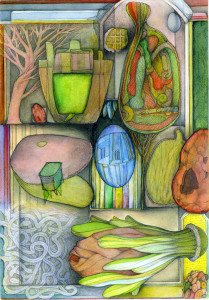 This year, Rhett is showing a series of watercolors and oil paintings. His watercolors were created over a series of bike rides around the Houghton area. Though he explores the form of the road over the landscape, the paintings are free of people or vehicles, creating a quiet moment in time. His brush strokes hold a lot of motion though the subjects are still. Through these careful studies made while in transit, he shows the beauty and intrigue that can be found along a journey, rather than in the destination.
This year, Rhett is showing a series of watercolors and oil paintings. His watercolors were created over a series of bike rides around the Houghton area. Though he explores the form of the road over the landscape, the paintings are free of people or vehicles, creating a quiet moment in time. His brush strokes hold a lot of motion though the subjects are still. Through these careful studies made while in transit, he shows the beauty and intrigue that can be found along a journey, rather than in the destination.
The show as a whole speaks to the life and experience of the artists around and in Houghton. The endless possible tessellation of mug zigurrat speaks to Murphy’s continuous drawings, Rhett’s attention to the ordinary to Huth’s detailed observations. Murphy writes, “People would not believe how seldom we interact throughout the year in what we are making. But come “showtime” we are linked in ways I find compelling and even a bit mystical – like the notion of “morphic resonance” we just seem to pick up each other’s sensibility and work with it. Our students of course do this. They follow each other’s lead and integrate into their work pieces of each other’s thinking. It stands to reason that even though we are not sharing a studio space like our students we do something of the same.”

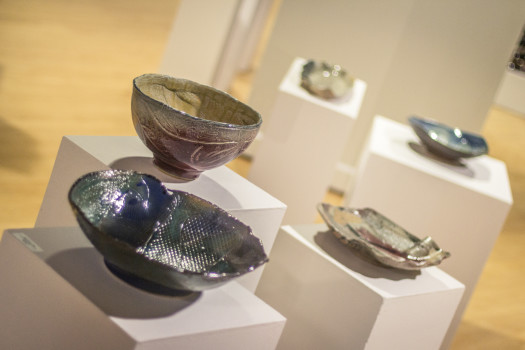
 It will begin this coming Tuesday, March 24th with a coffeehouse, poetry reading, Candle release, and printmaking t-shirts in the campus center basement; Wednesday will feature a short film and panel discussion lead by Title IX Coordinator, Nancy Murphy, featuring Professors Ted Murphy, Kristina Lacelle-Peterson, and Paul Young; lastly, Thursday will have workshops led by the Students For Gender Equality group with speaker Wendy Baxter. The night will conclude with a march around campus, beginning at the chapel steps, and a candle lighting in support of the survivors of sexual violence.
It will begin this coming Tuesday, March 24th with a coffeehouse, poetry reading, Candle release, and printmaking t-shirts in the campus center basement; Wednesday will feature a short film and panel discussion lead by Title IX Coordinator, Nancy Murphy, featuring Professors Ted Murphy, Kristina Lacelle-Peterson, and Paul Young; lastly, Thursday will have workshops led by the Students For Gender Equality group with speaker Wendy Baxter. The night will conclude with a march around campus, beginning at the chapel steps, and a candle lighting in support of the survivors of sexual violence.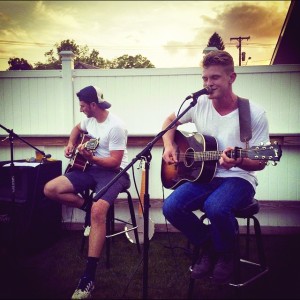 The group considers themselves to be outside the norm of Houghton bands, since they usually play outside the college and are not a worship band. Most of their following is also outside of the college, since there is a large audience for country music in the surrounding area. The band has done very well recently. They claim that this is due to the fact that there are not many local country bands in the area, and so there is a higher demand for their sound. Their Facebook page has over 350 likes and counting, they have played live gigs in Rushford, Olean and many other nearby towns, and they even competed this past summer in the Country Showdown in Olean and won second place.
The group considers themselves to be outside the norm of Houghton bands, since they usually play outside the college and are not a worship band. Most of their following is also outside of the college, since there is a large audience for country music in the surrounding area. The band has done very well recently. They claim that this is due to the fact that there are not many local country bands in the area, and so there is a higher demand for their sound. Their Facebook page has over 350 likes and counting, they have played live gigs in Rushford, Olean and many other nearby towns, and they even competed this past summer in the Country Showdown in Olean and won second place.